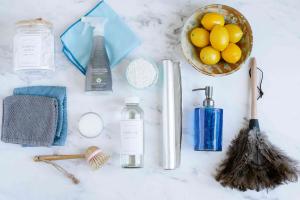How to Clean Metal: The Best Products & Methods for a Shiny Finish

-
Quick Links:
- Introduction
- Understanding Different Types of Metal
- Common Metal Cleaning Products
- Step-by-Step Cleaning Guide
- Expert Insights and Tips
- Case Studies: Real-World Applications
- Safety Considerations When Cleaning Metal
- FAQs
Introduction
Cleaning metal surfaces is essential for maintaining their beauty and longevity. Whether it's a cherished heirloom or everyday utensils, knowing how to properly clean and maintain metal can enhance its appearance and durability. In this comprehensive guide, we will explore various methods and products to achieve that coveted shiny finish on different types of metal.
Understanding Different Types of Metal
Before diving into cleaning methods, it's crucial to understand the types of metals you might encounter. Each metal has its unique properties and may require different cleaning techniques.
- Stainless Steel: Known for its corrosion resistance, stainless steel is used in kitchen appliances and fixtures.
- Aluminum: Lightweight and resistant to rust, aluminum is commonly used for outdoor furniture and vehicles.
- Copper: A beautiful metal that develops a patina over time; cleaning can restore its original shine.
- Brass: An alloy of copper and zinc, brass is often used for decorative items and fixtures.
- Iron: Prone to rust, iron furniture requires regular maintenance to prevent deterioration.
Common Metal Cleaning Products
Numerous products are available for cleaning metal surfaces. Below are some of the most effective options:
- Commercial Metal Cleaners: Products specifically designed for metal surfaces often contain chemicals that remove tarnish and grime.
- Vinegar: A natural alternative, vinegar is effective against tarnish and oxidation.
- Baking Soda: This versatile product can be used as a gentle abrasive cleaner.
- Dish Soap: Mild dish soap mixed with water can effectively clean metal without damaging it.
- Lemon Juice: The acidity in lemon juice helps break down stains and tarnish.
Step-by-Step Cleaning Guide
Cleaning metal can be straightforward if you follow these steps:
Step 1: Gather Your Supplies
Collect the necessary cleaning products, soft cloths, and brushes. Ensure you have protective gear like gloves if using harsh chemicals.
Step 2: Prepare the Area
Work in a well-ventilated area, especially if you're using strong cleaners. Lay down a protective covering on the surface beneath the metal item.
Step 3: Initial Dusting
Use a soft cloth to dust off any loose dirt and debris from the metal surface.
Step 4: Apply the Cleaning Solution
Depending on the type of metal, apply your chosen cleaning solution. For stainless steel, a commercial cleaner is effective. For copper, a vinegar solution works wonders.
Step 5: Scrub Gently
Use a soft brush or cloth to scrub the surface gently. Avoid abrasive materials that could scratch the metal.
Step 6: Rinse Thoroughly
After cleaning, use clean water to rinse off any residue from the cleaning solution.
Step 7: Dry and Polish
Use a dry microfiber cloth to wipe the surface dry. For an added shine, consider applying a metal polish according to the manufacturer’s instructions.
Expert Insights and Tips
Here are some expert tips to help you get the best results when cleaning metal:
- Always test a small, inconspicuous area first to ensure the cleaner doesn’t damage the finish.
- Use non-abrasive cloths and sponges to prevent scratching.
- Regular maintenance can prevent heavy tarnishing and make cleaning easier.
Case Studies: Real-World Applications
Several homeowners and businesses have shared their successful experiences with metal cleaning:
Case Study 1: Restoring Antique Copper
An antique store owner used a vinegar and salt solution to restore the shine of tarnished copper lamps. The results not only improved aesthetics but also increased sales.
Case Study 2: Maintaining Outdoor Aluminum Furniture
A family living near the coast found that regular cleaning with mild soap and water kept their aluminum patio furniture looking new, despite the salty air.
Safety Considerations When Cleaning Metal
While cleaning metal can be safe, always keep these safety tips in mind:
- Wear gloves when using harsh chemicals to protect your skin.
- Ensure proper ventilation to avoid inhaling fumes.
- Keep cleaning products out of reach of children and pets.
FAQs
- What is the best product for cleaning stainless steel?
Use a commercial stainless steel cleaner or a mixture of vinegar and water. - Can I use baking soda on all types of metal?
Baking soda is safe for most metals, but always test on a small area first. - How often should I clean my metal items?
Regular cleaning every few months is ideal to prevent tarnishing. - Is it safe to use bleach on metal?
Bleach can corrode certain metals; avoid using it unless specified for that metal type. - How do I remove rust from iron?
Use a rust remover or a mixture of vinegar and baking soda to scrub off rust. - What’s the best way to polish brass?
A commercial brass polish or a mixture of lemon juice and baking soda works well. - Can I use a power washer on outdoor metal furniture?
Yes, but use a low setting to avoid damaging the finish. - What should I avoid when cleaning metal?
Avoid abrasive materials and harsh chemicals that can scratch or corrode metal surfaces. - Why does metal tarnish?
Tarnishing is caused by exposure to moisture, air, and certain chemicals. - Can I clean metal with household items?
Yes, many household items like vinegar, lemon, and baking soda can effectively clean metal.
Random Reads
- How to install ssd in laptop
- How to install ssl certificate
- How to view open edit csv
- How to view passwords in credential manager windows
- How to block cookies
- How to block calls on messenger
- How to remove yourself from whitepages
- How to repair a concrete floor
- How to craft a jukebox on minecraft
- How to craft a hopper in minecraft